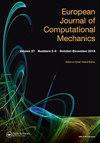Frictional Slip and Incremental Dynamic Analysis of Plate-rubber Bearing Continuous Girder Bridge by Ambient Temperature in Cold Region
IF 1.5
Q3 MECHANICS
引用次数: 0
Abstract
Special mechanical environment, the environmental temperature or stress transformation easily to the final mechanical properties of the bridge components performance changes. The impact of the cold zone environment on the plate rubber-bearing beams is the object of study, Jining Road refined mechanics finite element analysis of the structural dynamic response study under seismic action. The results show that low temperature leads to bearing friction slip and material parameter changes, which affects the self-oscillation frequency and seismic susceptibility of the bridge. Due to the temperature-induced changes in the material properties and mechanical properties of the bearings, the first principal period of the bridge increases by 3% at high temperature for the EH and decreases by 19% at low temperature for the EL when compared to the first principal period under normal temperature conditions. Under different extreme temperature conditions, the fundamental period of the bridge is longitudinal, and the effective mode vibration participation mass is more than 90%. The maximum crossover frequency VALmax reaches 75.6 dB. Compared with room temperature, the bearing stress increased by 27.6% to 45.5%. The effect of EL stress change should be considered in the design of bridges in the alpine region.冷区环境温度对板式橡胶支座连续梁桥的摩擦滑移和增量动力分析
特殊力学环境下,环境温度或应力的转变容易使桥梁构件的最终力学性能发生变化。以寒区环境对板式橡胶支座梁的影响为研究对象,济宁路精细力学有限元分析了地震作用下的结构动力响应研究。结果表明,低温导致支座摩擦滑移和材料参数变化,从而影响桥梁的自振频率和地震敏感性。与常温条件下的第一主周期相比,由于温度引起的材料特性和支座机械特性的变化,EH 型桥梁的第一主周期在高温条件下增加了 3%,EL 型桥梁的第一主周期在低温条件下减少了 19%。在不同的极端温度条件下,桥梁的基频为纵向,有效模态参振质量超过 90%。最大交叉频率 VALmax 达到 75.6 dB。与室温相比,轴承应力增加了 27.6% 至 45.5%。高寒地区的桥梁设计应考虑 EL 应力变化的影响。
本文章由计算机程序翻译,如有差异,请以英文原文为准。
求助全文
约1分钟内获得全文
求助全文

 求助内容:
求助内容: 应助结果提醒方式:
应助结果提醒方式:


